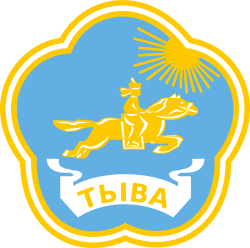Coat of arms of the Tuva Republic

The emblem of Tuva is a light blue field with a yellow border. In the center of the field is a traditional horseman, symbolizing Tuva's sovereignty and spirit. The coat of arms was created in 1992, and is similar to the present state emblem of Mongolia, which was adopted that same year.
Meaning of the colors
The yellow symbolizes gold and Buddhism. Blue symbolizes the morals of nomadic herdsmen (who are commonly respected in the region), as well the Tuvan sky. The blue pall symbolizes the confluence of the Bii-Khem (Bolshoy Yenisei) and Kaa-Khem (Maly Yenisei) rivers at the Tuvan capital of Kyzyl, where they form the Yenisei River, known to locals as the Ulug-Khem River. White symbolizes silver and virtue; additionally, it is common in Tuva for hostesses to greet guests with silver streamers in their arms.
Historical coats of arms
.svg.png) Coat of Arms of the Tuvan People's Republic (1926–1930)
Coat of Arms of the Tuvan People's Republic (1926–1930).svg.png) Coat of Arms of the Tuvan People's Republic (1930)
Coat of Arms of the Tuvan People's Republic (1930).svg.png) Coat of Arms of the Tuvan People's Republic (1930–1933)
Coat of Arms of the Tuvan People's Republic (1930–1933).svg.png) Coat of Arms of the Tuvan People's Republic (1933–1939)
Coat of Arms of the Tuvan People's Republic (1933–1939).svg.png) Coat of Arms of the Tuvan People's Republic (1939–1941)
Coat of Arms of the Tuvan People's Republic (1939–1941).svg.png) Coat of Arms of the Tuvan People's Republic (1941–1943)
Coat of Arms of the Tuvan People's Republic (1941–1943).svg.png) Coat of Arms of the Tuvan People's Republic (1943–1944)
Coat of Arms of the Tuvan People's Republic (1943–1944).svg.png) Coat of arms of the Tuvan Autonomous Soviet Socialist Republic (1944–1992)
Coat of arms of the Tuvan Autonomous Soviet Socialist Republic (1944–1992)
See also
- ↑ The status of Crimea and of the city of Sevastopol is since March 2014 under dispute between Russia and Ukraine; Ukraine and the majority of the international community consider Crimea to be an autonomous republic of Ukraine and Sevastopol to be one of Ukraine's cities with special status, while Russia, on the other hand, considers Crimea to be a federal subject of Russia and Sevastopol to be one of Russia's three federal cities.